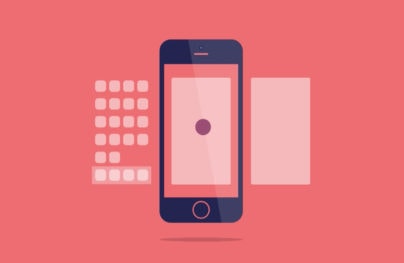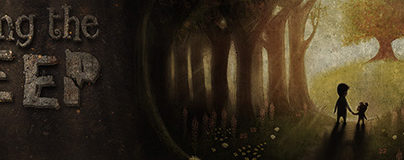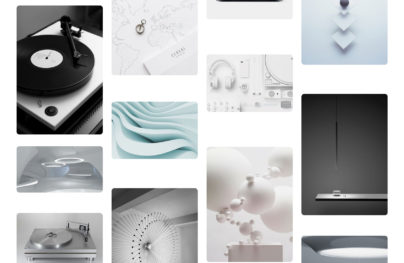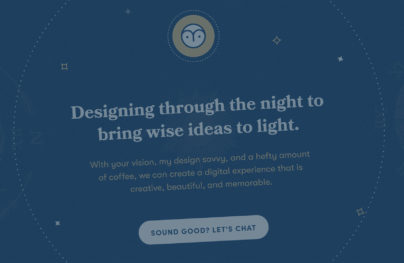Email Design Trends for 2025
As we move into 2025, email marketing remains one of the most effective tools for engaging customers and driving conversions. However, the expectations around email design are evolving rapidly. Today’s audiences demand emails that go beyond traditional design templates—emails that are visually engaging, interactive, and personalized to their preferences and needs. At the same time, technological advances, shifting user habits, and a growing awareness of accessibility and sustainability are shaping new design standards.
2024 was a productive and event-rich year for email marketing, particularly email design. It paraded numerous trends that uniquely shaped companies’ communications with clients and organizations in the channel.
- The integration of gamified and interactive elements into traditionally non-game contexts revolutionized email marketing campaigns and helped companies boost their conversions.
- Obsession with an eye-friendly, battery-saving dark mode encouraged companies to craft good email designs regardless of the user’s choice of display setting.
- Google and Yahoo’s updates on privacy forced companies to take email authentication seriously and made them think about the overall safety of email channels.
We also saw the rise of sustainability marketing, companies that ditched generic emails in favor of hyper-personalized approaches, and many newsletters with creative typography, nostalgic-inspired elements, monochromatic color schemes, and social media-inspired collages.
However, what does the new year have in store for us? Well, it will not be radically different, except for the technical side of email campaigns, as companies are now obliged to authenticate emails to meet Google and Yahoo requirements.
Many trends from the previous year have a huge momentum and do not show any signs of abating. This includes gamification and interactive details. AMP is becoming a more reliable and popular tool for delivering information and producing a powerful user experience. Expect to see companies exploit its potential to reach their marketing goals and reinforce brand identity.
Sustainable practices and accessibility will also remain, as companies are eager to show their commitment to society and establish socially responsible positions in the community. Smaller, less impactful trends, like nostalgic elements, will give way to new approaches.
With Postcards Email Builder you can create and edit email templates online without any coding skills! Includes more than 100 components to help you create custom emails templates faster than ever before.
Free Email BuilderFree Email Templates- 2020 Email Design Trends
- 2021 Email Design Trends
- 2022 Email Design Trends
- 2023 Email Design Trends
- 2024 Email Design Trends
Brands need to adapt to these emerging trends to stay relevant and maximize impact. This article will explore the most important email design trends shaping the landscape in 2025, from AI-driven personalization and interactive elements to dark mode optimization and sustainable design. By adopting these trends, brands can create emails that capture attention and deliver a richer, more engaging experience.
Whether you’re a designer, marketer, or business owner, understanding these trends will help you create powerful email campaigns that stand out in the inbox and keep your audience coming back for more. Let’s dive into what’s shaping email design in 2025 and how you can leverage these trends to enhance your email marketing strategy.
Importance of Following and Introducing Email Design Trends
Before we discuss email design trends for 2025, it is crucial to understand that leaning into popular solutions does not necessarily mean they help reach prime marketing goals.
Nevertheless, email design trends, in general, reflect a wider cultural shift. They help companies shape and deliver the message in a way that speaks to consumers in the same language. Aligning the brand with current aesthetics demonstrates to the target audience that the company understands their evolving tastes and makes an extra effort to meet their expectations.
Therefore, following email design trends and introducing them in the context of email marketing right now gives campaigns a much-needed edge. When played right, it helps the company:
- Stand out from the email clutter and separate from the boring, generic, and stale competition.
- Capture readers’ attention more efficiently and capitalize on their short attention span.
- Make the brand appear modern and high-tech, amplifying its overall aesthetics and making it look more enticing.
- Increase engagement with the brand and its products.
- Positively impact brand perception by reinforcing brand image and position in the market.
- Increase brand visibility and generate buzz around the email campaign and its message and offer.
- Spark new creative approaches and solutions in delivering the messages and revealing the company’s personality.
- Create opportunities to connect email and other communication channels, amplifying the marketing strategy.

Caker – Halloween Email Template
How to Introduce Email Design Trends 2025?
Incorporating trending elements in email design might greatly benefit the company, but it should be noted that unthinkingly chasing every emerging trend might lead to disaster. It is highly recommended to be trend-aware instead of trend-obsessed. When introducing trends, bear in mind these professional tips:
- Select trends that demonstrate your brand’s personality in the best possible light.
- Pick elements that add a contemporary touch.
- Adapt trends to your target audience and marketing goal.
- Embrace the spirit of the trend without diminishing the brand’s personality.
A professional email builder is a surefire way to introduce email design trends in 2025. It helps companies balance branding and trending and enhances productivity across levels by streamlining workflow. Consider Postcards’ email builder as vivid proof of that.
With Startup App and Slides App you can build unlimited websites using the online website editor which includes ready-made designed and coded elements, templates and themes.
Try Startup App Try Slides AppOther ProductsPostcards already have everything you might need to make your brand message look up-to-date. It has an assorted collection of hand-crafted blocks with modern styles and features. You may easily craft any layout, whether an eye-pleasing welcome email focused on a heart-warming message or a vibrant promo blast with a hard-to-miss call-to-action button.
In addition, you don’t have to worry about cross-platform consistency, as Postcards’ layouts and templates are fully responsive and mobile-friendly.

Postcards – Professional Email Builder
The Email Design Trends 2025
So, what trends will inspire email marketers and shape communication in the channel next year? Here is a short list.
Data Privacy Inspired Series
Updates in data privacy are among the first important trends in email design to follow and adapt. In recent years, the landscape has been dynamic and evolving, setting rules for email campaigns and conveying the company’s branding message to the target audience.
As malicious actors become more artful, they generate approximately 3.4 billion phishing emails daily, to say nothing about causing data breaches and million-dollar losses for companies. Users require strong protection in the email channel since it remains one of the most popular and, unfortunately, vulnerable means of communication in both the B2C and B2B sectors.
In 2024, several important updates in data privacy protection addressed this situation. ePrivacy Regulation, intended to complement GDPR, came into effect. It entails stricter rules on electronic communications, cookies, and direct marketing. In short, it provides enhanced consent requirements and ensures the confidentiality of electronic communications.
France, Germany, and Spain updated national data protection laws to tackle specific local issues.
The Artificial Intelligence Act is anticipated to be finalized in 2024.
A dozen of U.S. states made domestic policy updates.
Finally, Google and Yahoo enforced new protection standards for bulk email senders. Both industry leaders focused on three key aspects businesses and entrepreneurs should prioritize to be seen as legitimate. This includes:
- Authentication of emails. From now on, senders generating more than 5000 messages daily must verify their sender identities with SPF, DKIM, and DMARC.
- Fast and efficient unsubscribe option. Every digital newsletter should have the single-click unsubscribe capability.
- A spam rate threshold. Mailbox providers start seriously considering the engagement level of communication between brands and their subscribers.
So, what does it mean for the email design sphere? Even though primarily these changes affect the technical side of email, they still influence the way company craft their branding messages, as they need to meet newly-founded requirements:
- Provide an easy unsubscribe option
- Communicate privacy policies
- Build trust
- Increase engagement with the audience
Apart from authenticating emails with custom SPF, DKIM, and DMARC and registering domain for Google Postmaster Tools, we expect to see businesses focus more on perfecting double opt-ins, clear and fast opt-outs, and simple solutions for subscribers to control their preferences. Here are three emerging trends in email design based on that.
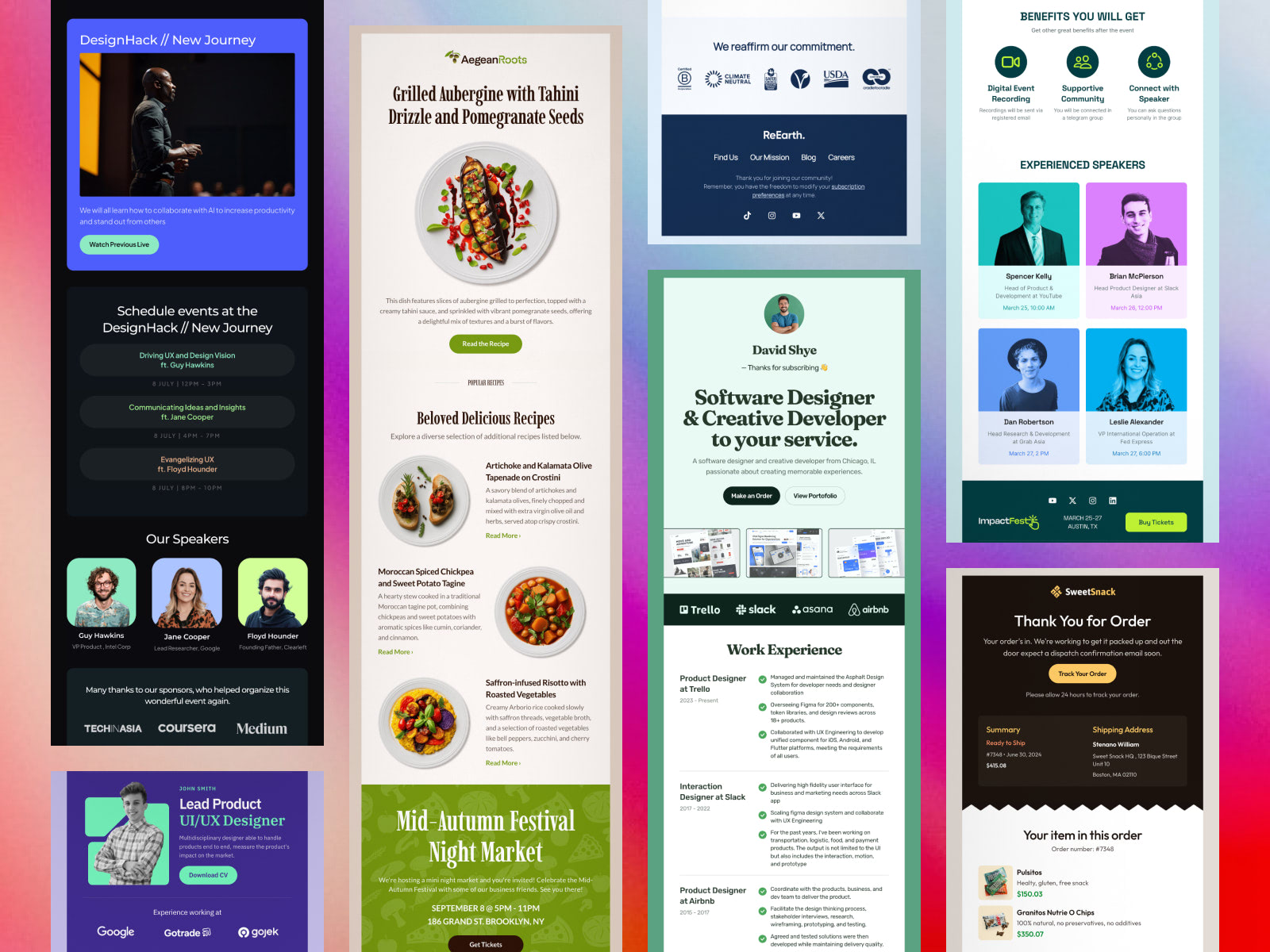
Visually-Appealing Confirmation Emails to Perfect Double Opt-In
Did you know that over 60% of subscribers believe confirmation emails are critical to their newly established brand relationships? Verifying the email address and acknowledging the transaction or event between the company and the individual are the most critical first interactions.
As more people crave personalized experiences in email channels, expect companies to ditch robot-like messages and opt for meaningful, impactful, and personal interactions at this touchpoint. In terms of email design, this means more vibrant, branded newsletters with a visually appealing experience. To follow this trend, add illustrations, animated gifs, or dynamic elements and highlight brand identity.
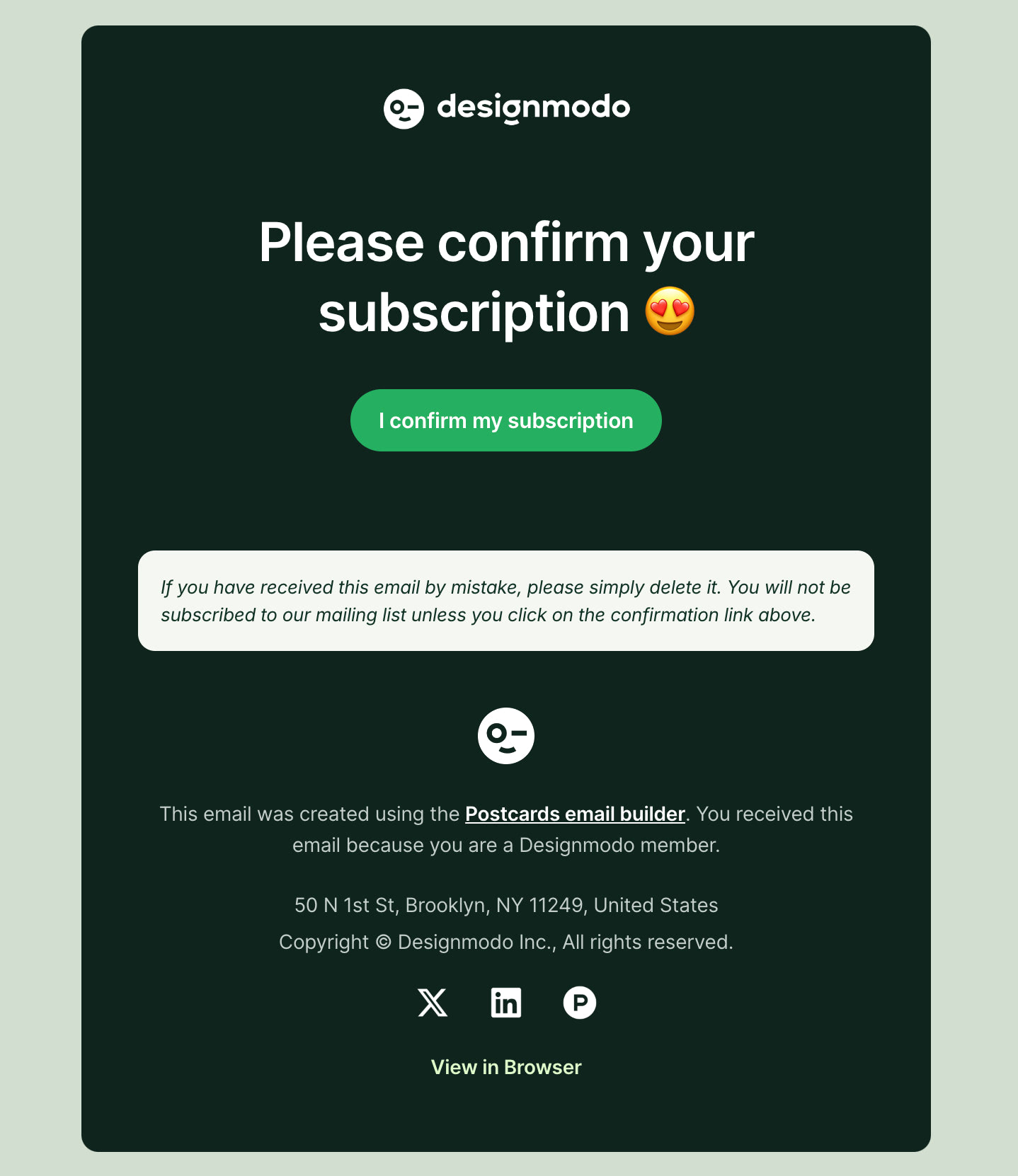
A Confirmation Email from Designmodo
Personalized Emails Dedicated to Preference Centers
One way to keep up with new legislation and maintain people’s interest in the brand is to let them decide what they want to receive from your brand and how often they want to get it. Many big companies have introduced this tactic by regularly inviting their subscribers to visit preference centers and adjusting their email environment according to their current preferences, needs, and demands.
2025 will witness more such emails as companies recognize the power of letting customers control digital correspondence. To play along, personalize emails, spotlight important information, capitalize on branding features, and use eye-pleasing design to produce favorable impressions.
Highlighted Unsubscribe Links
The latest regulations and updates from Google and Yahoo require bulk senders to ensure a one-click unsubscribe option with a clean and conspicuous process. As companies adapt to these new rules, their focus will be applied to this functionality.
An unsubscribe link is traditionally located at the bottom of the digital newsletter. Its position might stay unchanged since customers get used to finding it there. But, it will certainly become more prominent so that customers can easily discern it from the text and refer to it whenever they want. Expect brands to stress out this critical detail in the content through formatting and styles.

Perfectly highlighted unsubscribe link in Rogue template by Designmodo
Email disclaimers fulfill some legal requirements and reassure consumers that a company’s policies align with the GDPR. Many huge brands, like Apple, already feature privacy disclaimers in their emails. With tightened security measures, more brands will adapt to this practice. So, expect email designs with prominent and highly informative footer areas that feature this kind of data:
- Company’s contact information and physical address.
- Confidentiality statement.
- A brief privacy policy statement.
- Security measures.
- Alternative ways for customers to get in touch with a company.
- Copyright and trademark notice.
- Terms, conditions, or offer restrictions in promotional emails.
It is crucial to note that the email disclaimer is valuable real estate, as readers know it as a place to look for vital information. Therefore, it is highly recommended that you lay out your disclaimers so readers can easily scan and find what they need. Provide optimal readability and use proper formatting to convey information pleasantly.
Hyper-Personalization with AI-Driven Content
In 2025, hyper-personalization powered by artificial intelligence (AI) is revolutionizing how brands connect with customers through email. AI algorithms now analyze vast amounts of user data to craft emails uniquely tailored to each recipient, far beyond basic name personalization. AI-driven personalization leverages past purchases, browsing history, location, preferences, and even behavioral patterns to dynamically update content within the email. The result is a more relevant, engaging experience that drives higher open rates, click-throughs, and conversions.
Key Applications of AI in Email Personalization
- Dynamic Product Recommendations: AI algorithms can analyze past interactions to suggest products they’re more likely to purchase. For instance, AI can prioritize similar items in upcoming emails if a customer recently browsed athletic wear.
- Content Customization Based on Behavior: AI can adjust the content, images, or calls to action based on each user’s previous behaviors. For example, someone frequently engaging with travel content might see destination recommendations, while another user might see local offers instead.
- Predictive Send Times: AI can help brands send emails when a user is most likely to engage. AI can optimize delivery timing for each subscriber by analyzing when individual recipients typically open emails, ensuring higher open rates.
Balancing AI-Driven Personalization with Privacy
While AI enhances email relevance, it’s crucial to strike a balance with user privacy. Transparency in data usage, clear opt-in options, and adherence to privacy regulations are essential to maintaining customer trust. Brands can offer users control over their preferences, letting them opt into specific types of personalization.
Implementing AI-Driven Personalization: Tips & Best Practices
- Leverage Tools that Integrate AI Seamlessly: Many email marketing platforms now offer built-in AI tools to help brands create dynamic, personalized content easily. Look for platforms that allow data integration from CRMs, browsing behavior, and purchase history to utilize personalization fully.
- Start Small and Scale: AI capabilities are powerful but best implemented incrementally. Start with one or two personalization elements, such as product recommendations or optimized send times, and expand as you gauge results.
- Test and Refine Regularly: AI algorithms improve with more data, so regular testing and refining are essential. A/B testing different personalization elements can help identify which strategies drive the best engagement for your audience.
Hyper-personalization with AI is transforming email marketing from a one-size-fits-all approach to an individualized experience that resonates with each subscriber. By adopting AI-powered strategies thoughtfully, brands can build stronger connections with customers, keep emails out of the spam folder, and drive meaningful engagement through their email campaigns.
Sustainability and Ethical Marketing
There has been a notable shift in recent years, with businesses recognizing the importance of ethical practices. Last year, we saw industry leaders embrace this trend, and 2025 will not be any different. Hubspot says almost 50% of Gen Z and Millennials prefer brands that advocate for social causes. Users demand transparency, integrity, sustainability, and environmentally friendly practices from their beloved brands.
Brands that follow this mainstream have an opportunity not just to stay afloat and meet current consumers’ demands but also to build much-needed trust with an ever-evolving market, connect with conscious customers, create a positive societal and environmental impact, and establish the company as a responsive and reliable partner in the email environment.
How to Follow Ethical Marketing Trends in 2025
Apart from running email campaigns in a way that does not harm the environment, many companies use their digital correspondence to demonstrate their socially responsible position to the target audience.
Some brands are not afraid to be open about becoming more ethical and sustainable. Using digital newsletters, they inform customers about events and causes they participated in through visual reports or infographics.
Other brands lead with transparency and show the human side of their company by giving a glimpse into their prolific working culture. They include images of corporate events or employees.
In terms of email design, all of them demonstrate their ethical and eco-friendly position through styles associated with ecological aesthetics. This implies using many earthy and natural colors, authentic and raw imagery, and simple structures.
An alternative way to state your socially responsible and environmentally friendly position is by adopting practices that help to reduce email carbon footprint.
- Minimize email size by choosing compact structures.
- Avoid complex HTML, CSS, or JavaScript code to optimize loading time.
- Reduce image size.
- Cut down the number of images and graphic material in emails.
- Include only the necessary information.
These practices imply that companies will embrace minimalism with a focus on the critical message. So, expect compact digital newsletters with well-optimized images, less visual appeal, simple layouts with basic colors, and easy-to-read text snippets.
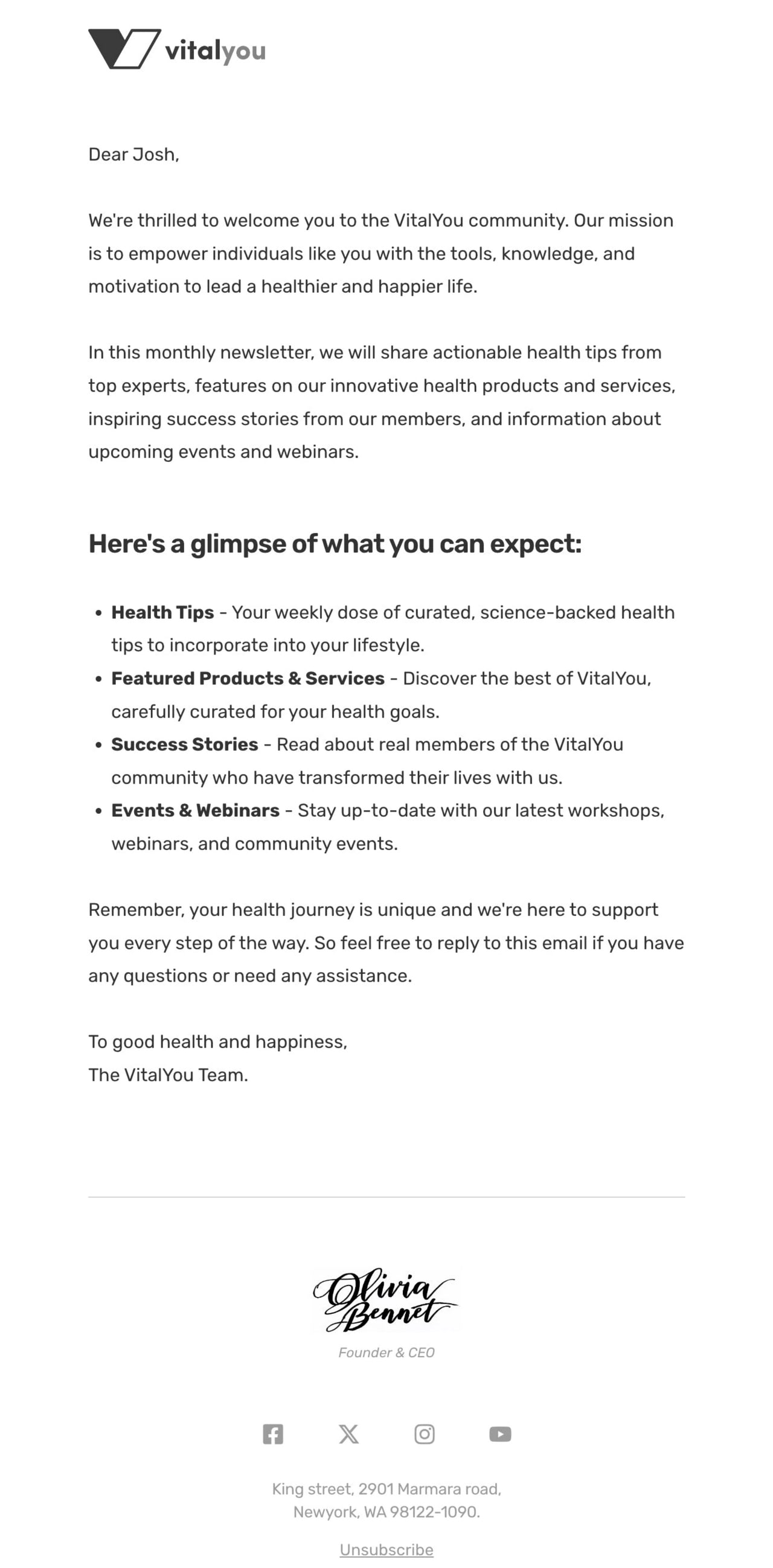
Oversimplified text-only email template by Designmodo
Interactive Elements and Gamified Experiences
This may sound counterintuitive to the previous trend, but the rise of interactive emails and gamified experiences is evident. Occupying the other side of the spectrum, they have been exciting the minds of email marketers and bringing exceptional user experience to subscribers for several years already. Just consider their potential.
- Interactive email design can potentially increase click-through rate by over 70%, according to Martech Advisor.
- AMP can increase engagement and conversions by up to 500%.
- 91% of consumers want to receive interactive emails in their inboxes, and over 60% are likely to engage with such content more deeply, according to Litmus and Dyspatch.
With such a powerful effect on subscriber engagement, to say nothing about a tidal wave of new opportunities to maximize ROI from a single email, interactive emails are one of the most important approaches to embrace next year if you want to beat your competition and take your email campaigns to the next level.
Let’s consider the most popular solutions to adopt this trend in B2C and B2B sectors.
Interactive Emails in B2C Email Marketing
The B2C sector, perhaps, is the one that enjoys the most benefits from introducing this trend in their campaigns and strategies. Kinetic emails might drastically increase the click-through rate because customers are prone to spur-on-moment decisions and naturally fall for entertaining details. Here are some popular use-case scenarios:
- Invite subscribers to browse and see the highlights of your product through an animated image carousel.
- Provide instructional content or create the step-by-step guide in a visual format with dynamic tooltips and hotspots.
- Enhance infographic-inspired emails with dynamic details.
- Add a calendar to simplify the booking process.
- Use discount codes with gamification to enhance promo sales.
- Include polls to collect real-time interest indicators and understand your audience better.
- Request a review via the form or quizzes to get valuable insights.
- Allow recipients to add the items to their cart to create a more seamless checkout process and ipso facto reinforce the abandoned cart tactic.
- Serve content in a digestible manner through tabbed elements.
- Create gamified experiences to celebrate events, anniversaries, and milestones.
Indeed, interactive emails offer various solutions for B2C email marketers, from tiny hamburger menus to huge accordions.
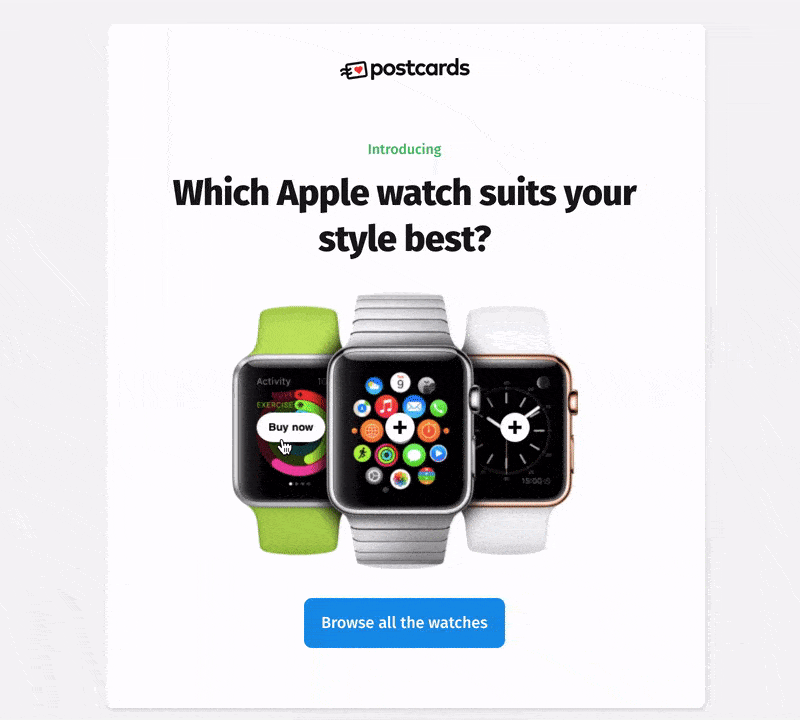
Use of hotspots in Postcards templates
Interactive Emails in B2B Email Marketing
Even though B2B is considered a sector with strictly professional communication, it also benefits from kinetic emails as they might efficiently remove some of the barriers in the sales funnel. In 2025, email marketers will use them for these tasks:
- Drive new user adoption of their product.
- Collect product feedback.
- Simplify or speed up event registration by linking to the online calendar.
- Have users RSVP via email with a quick form and an easy-to-use submit button.
- Ask clients to comment, leave feedback, or rate products.
- Encourage users to reply to an actual email through Google form paired with AMP.
- Improve onboarding flows with interactive guides.
Last year, we only scratched the surface of the possibilities of interactivity in email. With a broader adaptation of AMP, this trend will eventually become an integral email marketing tool. Therefore, expect kinetic emails of various kinds in 2025.
Mobile-First Email Designs
Mobile phones are ubiquitous and integral to our lives, not only personal but also professional. The work landscape is slowly shifting towards a more flexible working environment where employees use tablets and cell phones to complete tasks.
The mobile-first email designs are trending and increasingly important to creating successful email campaigns in 2025. Just consider the recent stats:
- Over 80% of emails are now opened on mobile instead of desktop.
- Apple iPhone’s iOS Mail had almost 40% of the market share of all email clients last year.
- Mobile users check their email 3x more often than desktop users.
Furthermore, 35% of professionals use their smartphones to check their emails. This means that even in the B2B sector, where consumers are likely to open their business correspondence on their desktops in the office, companies have to adapt their email designs to mobile-first realities to meet people’s evolving demands and preferences.
What does this mean for email design in 2025? Three emerging subtrends in this area will shape next year’s digital correspondence.
Single-Column Layout
The first and foremost, mobile-first approach implies designers adopt a one-column structure as it perfectly embraces the content, serves it consistently across all screen sizes, and gives a reader a directed flow of content. So, expect to see more email designs with a straightforward and linear arrangement that presents information in a clear and easy-to-read manner.
“Above the Fold” Approach
The “above-the-fold” approach implies that companies must place the most important information first so that users get all the critical details of the message before they scroll down, capitalizing on short attention spans.
It is increasingly popular in mobile-first design. In marketing, it boosts conversion and click-through rates as it handles the real estate that gets the most attention from viewers. Therefore, more companies are expected to introduce it in their email designs.
To follow this subtrend, consider crafting enhanced hero areas based on the inverted pyramid principle, impressive backgrounds, and well-highlighted CTAs. Include branding elements, the unsubscribe button, the main offer or value proposition, and all critical information.
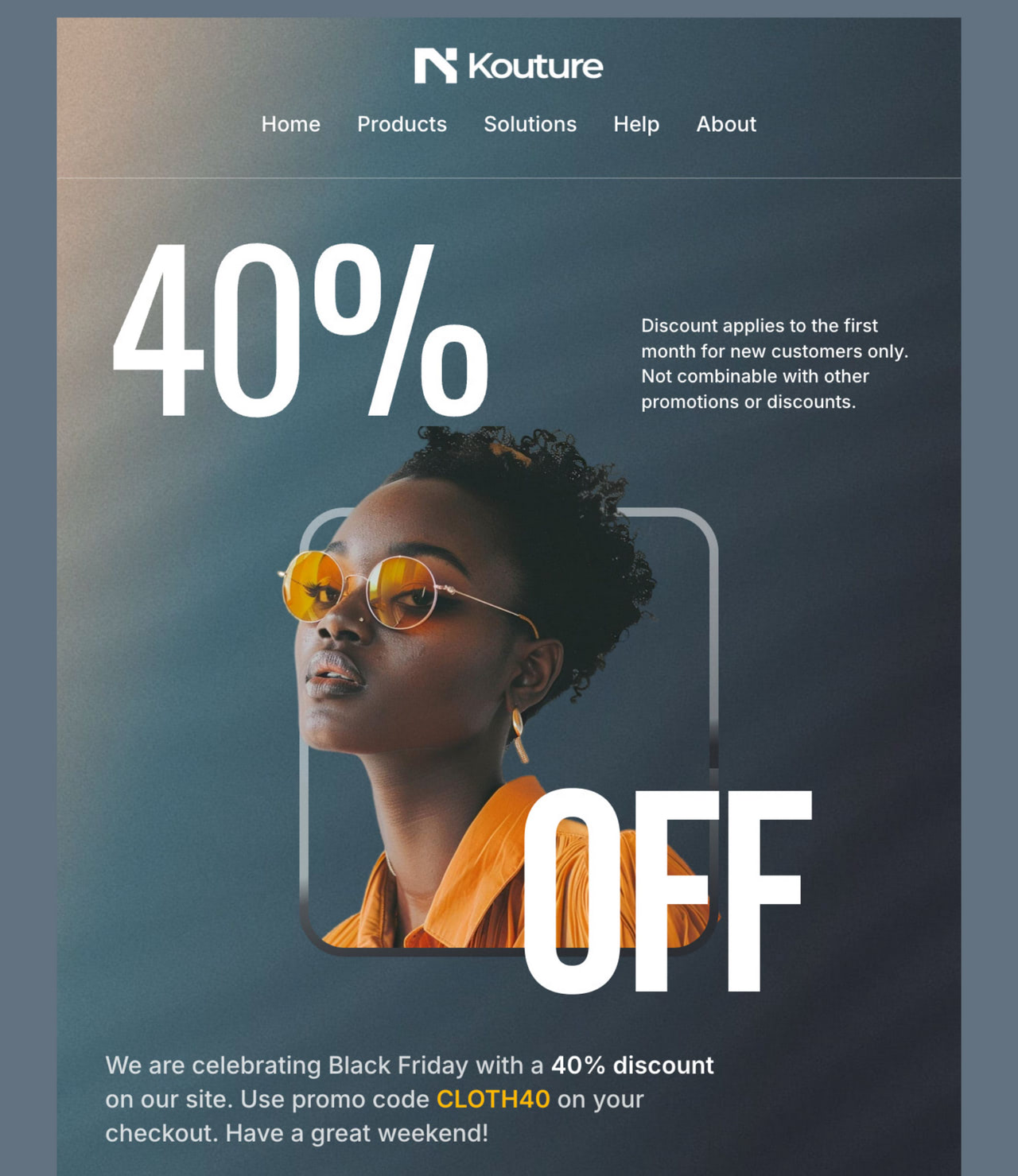
High-converting hero area in Kouture template by Designmodo
“Cut to the Chase” Philosophy
With mobile-first email designs, companies do not have the luxury of creating a long storytelling experience. Nobody likes to scroll forever, especially on small screen sizes. Keeping the content snappy is the only way to meet users’ needs and preferences.
Therefore, you might see more digital newsletters that get to the point right away next year. Though, this does not mean they will be boring. With the rising trend of interactive experiences, they might include all sorts of features that bring joy and entertainment to the crowd.
One more thing.
It is crucial to note that mobile-first email design means that even though you craft the experience first for cell phone users, you still underlie a solid foundation for building an optimal experience for all devices as you think through progressive enhancement, graceful degradation, and email structure scalability. This strategy enhances the accessibility side of your email experience and meets one of the essential standards by eliminating an obstacle to getting information regardless of device.
Adopting a truly mobile-first mindset takes time. However, you can speed it up by using special software like Postcards. As a professional email design builder, it has everything email marketing teams need to assemble mobile-first structures.
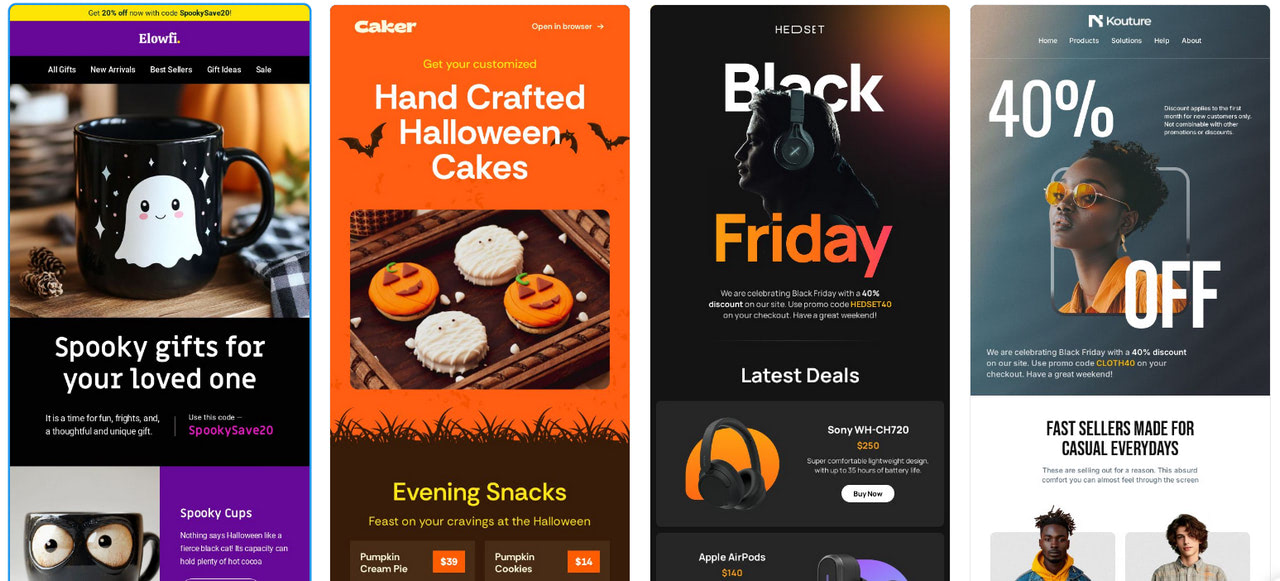
Mobile-first email templates from Designmodo
Mobile-First Micro-Animations
In 2025, mobile-first design remains a cornerstone of email marketing strategy, with micro-animations adding a new layer of engagement to the mobile experience. These subtle, lightweight animations are optimized for mobile devices, helping brands captivate users without compromising email load time or usability. Micro-animations, such as loading indicators, animated icons, and hover effects, enhance the visual appeal and interactivity of emails, making them more engaging and enjoyable to interact with on mobile screens.
Benefits of Mobile-First Micro-Animations
- Improved User Experience: Micro-animations guide users through content intuitively, making it easy to understand interactions like swiping or tapping. They can draw attention to specific actions or products without overwhelming the user.
- Enhanced Visual Engagement: Small, purposeful animations break up static content, creating a more dynamic viewing experience. For example, an animated arrow can encourage users to scroll, or a slight bounce effect can make a CTA button more enticing to tap.
- Brand Personality and Tone: Micro-animations subtly reflect a brand’s personality, making emails feel more alive and memorable. Fun, responsive icons or loading animations can create a more personable and engaging brand experience.
Best Practices for Implementing Micro-Animations in Mobile-First Emails
- Prioritize Performance: Because mobile users are sensitive to load times, ensure that animations don’t impact performance. Keep animations lightweight, and use CSS animations instead of GIFs whenever possible to minimize file sizes.
- Use Animation Purposefully: Micro-animations should have a clear purpose, such as highlighting a CTA, illustrating a product feature, or improving navigation. Avoid unnecessary animations, which can be distracting and may reduce user engagement.
- Test Across Devices and Email Clients: Not all email clients support animations equally, so testing emails on various devices and platforms is essential. For example, Apple’s iOS Mail supports many CSS animations, while others, like Gmail, might have limitations. Consider fallback designs for clients that don’t support animations.
- Optimize for Touch Interactions: Since mobile users interact with their fingers rather than a mouse, animations should be designed with touch gestures. For instance, subtle animations on tap, swipe, or hold can enhance interaction without requiring pinpoint precision.
Examples of Effective Micro-Animations
- Animated Call-to-Action Buttons: A slight pulse or color change on the CTA button when a user taps or scrolls can make the button more inviting and encourage clicks.
- Loading Indicators for Rich Content: If an email contains video previews or interactive elements, a quick-loading animation reassures users that the content is loading. This can improve retention, especially on slower connections.
- Animated Icons for Product Highlights: Small animations, like a heart “popping” when favoriting a product or a cart “wobbling” on an add-to-cart action, make interactions fun and reinforce actions visually.
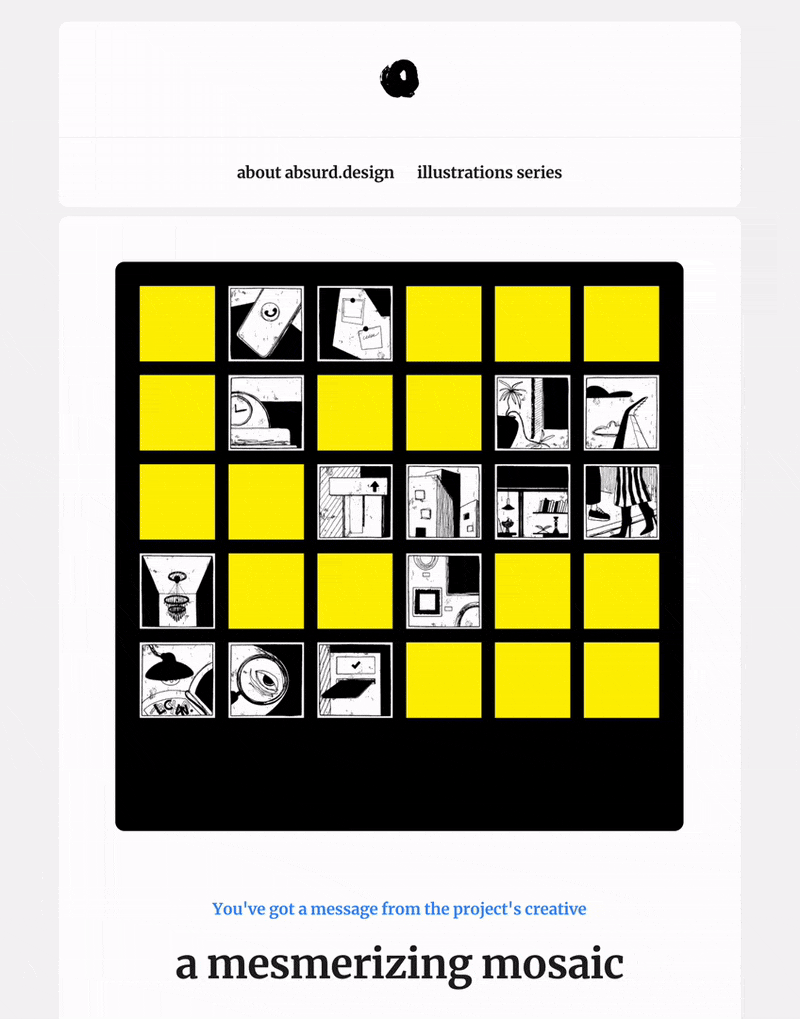
Email Design and Animation by absurd.design
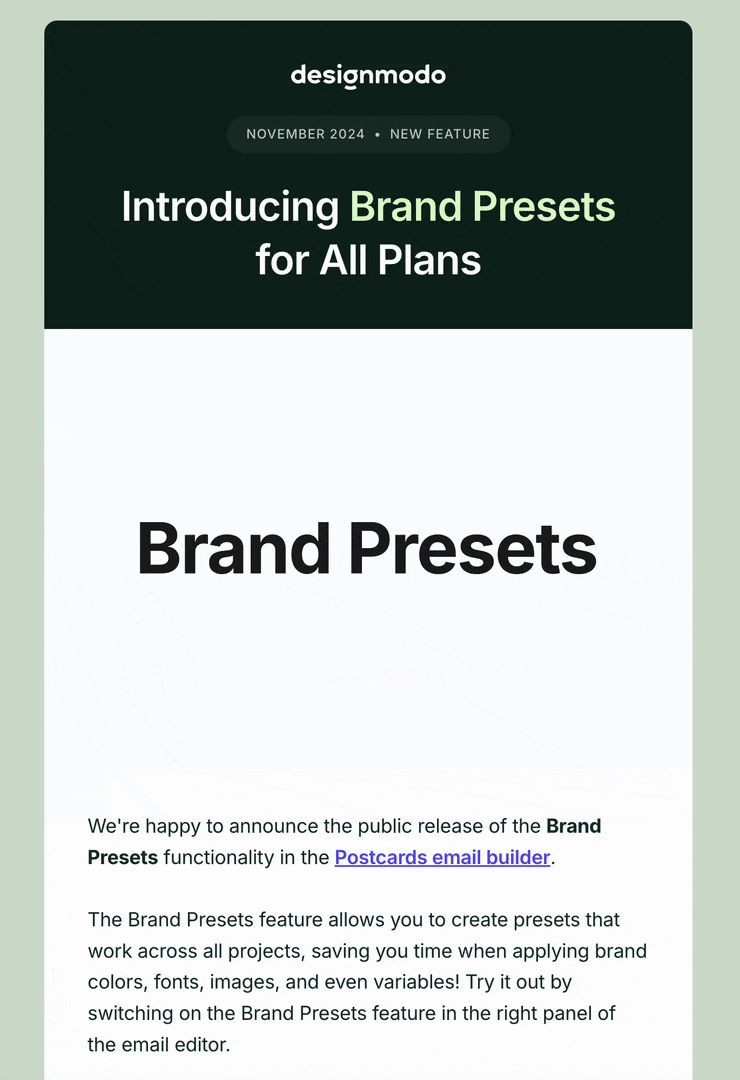
Designmodo Email Animation
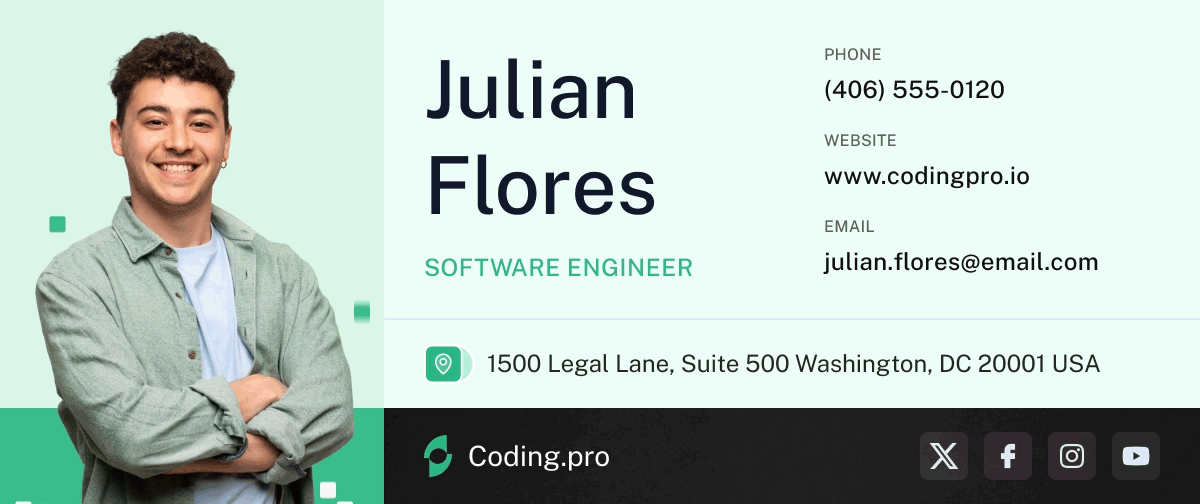
Animated Email Signature Template
By incorporating mobile-first micro-animations, brands can create emails that feel more dynamic and tailored to the mobile user’s experience. Thoughtfully designed micro-animations elevate the aesthetic and enhance usability, turning ordinary emails into interactive experiences that encourage engagement and action.
Email marketing is gradually shifting towards hyper-personalized relationship-based communication between companies and clients. More businesses focus on individuals’ behavior, preferences, and purchasing histories to create a highly relevant, engaging branding message and meaningful connection.
Consider recent statistics that demonstrate the importance and popularity of hyper-personalization and relationship-based correspondence:
- Personalized email marketing sees a higher revenue than generic one.
- Personalized emails achieve an impressive open rate of almost 30%, directly affecting the click-through rate.
- Over 70% of consumers expect personalization and will get annoyed when it doesn’t.
This trend will stay and occupy the minds of email marketers in 2025.
The good news is that, with the rapid advancement of technologies and AI, email marketers have a golden opportunity to create campaigns beyond simply addressing recipients by name in the copy or subject line. They have tools to thoroughly analyze customer data, better understand clients’ demands, accurately decide on offers and user-specific product recommendations, and even predict customer behavior to provide corresponding content.
So, how can you keep up with it and make it work for you? Here are some ideas:
Craft Impressive Welcome Email Designs
As the first interaction point, welcome emails underlie a solid foundation for healthy, strong, and productive customer relationships. Many companies have already recognized their potential. They have invested in this transactional type of newsletter over several years.
This tendency is going to be a key in 2025. Expect companies to exercise their creativity and put their efforts, time, and money into creating impressive, rich, and approachable welcome email designs that bridge the gap between the company and its subscribers and secure a powerful first impression.

Welcome email template by Designmodo
Entertain with Onboarding Emails
Another area where you might see the trend is in onboarding emails. As the first critical step in integration, onboarding emails are vital for clients to feel comfortable in their newly established relationships with the company and enjoy all the benefits of the product or service.
You might have noticed how onboarding emails have transformed from boring text-only pieces into engaging and entertaining media-rich newsletters. Not only do they inform and guide customers through the adaptation process, but they also entertain and produce favorable, long-lasting impressions.
In 2025, companies will take them to the next level by introducing bright graphics, infographics, illustrations, dynamic elements, and interactive features to produce an outstanding user experience.
Run Heart-Warming Appreciation Campaigns
The trend of developing relationship-centric email marketing campaigns revolves around appreciation emails. A staggering 80% of respondents said that these interactions with companies are important, forcing companies to shift their attention to thank you notes, birthday and holiday congratulations, rewards emails, apology emails, milestone acknowledgments, customer achievements, and anniversaries.
Regarding email design, behavioral newsletters have been constantly improved to meet the relevant preferences and expectations of the target audience. Today, they are not just a simple acknowledgment of the client’s importance—they are tools that produce powerful, long-lasting impressions through stimulating experiences.
In 2025, they will continue to do that by employing the power of styles and interactive features. Expect brighter and more vibrant email designs, branded illustrations, authentic messages, and dynamic details that take gratitude newsletters to the next level.

Appreciation email template by Designmodo
Digest-Format Emails
The digest format is one of the emerging trends in email marketing. Last year, we saw companies adopt it in their campaigns to drive engagement, generate traffic, improve customer relationships, and generate much-need click-through rates and conversions. 2025 will not be an exception, as the trend is gaining steady momentum.
The digest format is a term used to describe a compact and intentionally minimized magazine format, in contrast to popular yet larger options like Pulp. It is meant to be a short version of your intended article or blog posts, facilitating quick and easy reviews and providing a convenient way for readers to tote around.
YouTube and TikTok have revamped it, making it an integral medium for users to overview the latest trends. Capitalizing on a short attention span and keeping interaction snappy, efficient, and productive, it has found its way to email channels, one of the most popular means of communication between companies and clients.
Therefore, expect more of these compact, tightly packed, yet well-formatted emails in 2025. To play along with this trend, follow these practices:
- Select only relevant and valuable information.
- Feature short snippets of content so users can quickly jump to what interests them.
- Enrich snippets with visuals: images, illustrations, and simple graphics may amplify the informative side, improve the overall reading experience, and let your users enjoy the newsletter even more.
- Maintain a balance between text and images. While visuals should complement copy and help readers understand the context, they should not overwhelm them.
- Keep the number of snippets low. Do not make your subscribers wade through endless amounts of text. Four to five data blocks are enough.
- Divide your information into primary and secondary using formatting and styles.
- Use enough white space to give breathing room between the elements of an email.
There are many ways to design digest-inspired emails, but a single layout is one of the simplest and most popular. It provides enough space to write catchy descriptions and use large accompanying visuals. It also creates a natural path for your reader to move along the message and offers optimal user experience across devices and screens.
Alternatively, you may organize your content in two or three columns. These layouts allow you to demonstrate more information within a small space, making scanning easy and fast.

Digest-format in Nadafest email template by Designmodo
Accessibility in Email Design
Accessibility in email design is not a trend, but we could not help but mention it here as it has become a must-have feature. With ethical marketing and sustainability practices dominating in 2025, it is crucial to consider your audience’s different needs and show your commitment to them.
Apart from meeting the needs of disabled or temporarily impaired people, who account for over 15% of the world’s population, accessible email design helps every person navigate and read content efficiently. Whether they use screen reading devices or read your email on a ridiculously small smartphone, accessible email design allows everyone to get your message, interact with it, and enjoy the overall experience you intend to deliver.
Check out our guide to accessibility in email design to meet this critical requirement in 2025.
Conclusion
As we look ahead, email design trends in 2025 are set to redefine how brands connect with their audiences through email. From hyper-personalization powered by AI and interactive elements to mobile-first micro-animations and a strong focus on accessibility, these trends are more than just design choices—they’re strategies for building more meaningful, engaging experiences. Adopting these trends allows brands to stay relevant, boost engagement, and make emails stand out in increasingly crowded inboxes.
Implementing email design trends for 2025 doesn’t have to happen simultaneously. Start by experimenting with one or two trends, measuring open rates, click-throughs, and conversions. You can consistently deliver emails that capture attention and foster brand loyalty by staying adaptable and open to innovation.
Incorporating these trends can give your campaigns a fresh, cutting-edge appeal that resonates with modern audiences. In 2025, embrace the future of email marketing by integrating the latest email design trends and transform your email strategy into a powerful tool for driving growth.
Email marketing constantly changes to meet its target audience’s ever-evolving preferences, demands, and expectations. Last year, it was rich in nostalgia-inspired solutions and black mode. This year revolves around ethical and sustainability practices, interactive user experiences, and relationship-based communication.
While unthinkingly following every emerging trend may lead to disaster, ignoring them may result in worse outcomes. Looking stale, boring, and outdated may destroy even the strongest brand’s presence and position.
Meanwhile, smartly following email design trends makes companies feel like they belong somewhere and get a sense of approval from consumers. It gives them a cutting-edge advantage over competitors and helps them achieve marketing goals more efficiently. Therefore, it is crucial to balance being modern and practical when introducing email design trends.
As 2025 is marked by ethical marketing, accessibility, and enhanced data privacy, looking modest and smart is the surefire way to strike the right chord with the target audience. Choose trends highlighting the best side of your brand personality and use Postcards to ensure your message and design look refreshing, contemporary, and coherent across devices and platforms.
